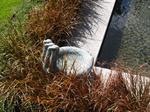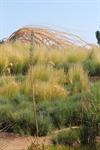Using Ornamental Grasses For Year Round Effect
Grasses provide a different and distinctive effect in the garden. Their flower heads may not be as brightly coloured as some plants, but the ornamental grasses and their close relatives – bamboos, rushes and sedges – have many other appealing attributes.

Their simple, graceful form, strong vertical outlines and unusual flowers provide a great contrast to other plants commonly found in the garden. They are often fine textured, adding a soothing element to any garden. Some are edible, while others are used as filters to clean grey water.
Grasses are Diverse
Grasses are one of the largest families of flowering plants. They range in size from tiny creeping or clumping species through to magnificent tropical bamboos.
They have other varied features:
- Foliage colours – grasses aren’t just green! Ornamental grass colours include red, blue, black, brown, bronze, silver, white, variegated and even gold tones
- Flower colours – includes green, yellow, pink, silver, brown and green.
- Leaf textures – some have broad leaves and fleshy stalks; others have narrow or wispy leaves
- Flower and seed heads – some have showy plumes or spikes, others are small and wispy
- Form – some are upright; others have drooping foliage
- Some are invasive; some are not
- Some grow in very wet soil; some in dry
Ways to use Grasses in a Garden

Grasses can be used for much more than just lawn:
- Plant a whole garden or section of a garden with nothing but ornamental grasses
- Grow them in pots or tubs as a specimen
- Plant them as a border or hedge to contrast with plants behind
- Grow small varieties in the gaps between paving stones
- Grow moisture-tolerant species in moist soil, in bog gardens or beside ponds
- Grow them in narrow garden beds
- Grow the smaller clumping varieties in rockeries
- Plant them with broad-leaved plants as part of a mixed garden bed
- Grow them to attract seed-eating birds
- Grow them as a soft barrier, lemongrass repels the advance of kikuyu and couch
- As an understorey planting to a feature tree
GRASSES TO GROW
Bamboo
Bamboos are a diverse group of grasses. They range from small types suitable for a pot through to towering giants. Some have invasive roots, others form clumps. The timber from bamboo is used for buildings and tools; even the reeds are used by saxophone players! Some are edible and they provide habitat for reptiles and birds. They also make an great screening plant.
Bamboo requires rich, fertile soil and an annual addition of manure and compost.
They can be propagated by division of the roots or from stem cuttings.
- Phyllostachys nigra – Black Bamboo grows 3m or more and has spectacular black stems
- Bambusa vulgaris cv. "Vittata" —Bright green stripes on golden yellow stems
- Bambusa longispiculata – ivory stripes on light green stems
- Dendrocalamus sikkimensis – orange tinted stems
- Gigantochloa albociliata – cream stripes on light grey-green stems
- Schizostachyum brachycladum – striped leaves and stripes on ivory gold stems
- Bambusa multiplex - this and the cultivars of this species are ideal for screening. Specialist bamboo nurseries can advise on the most appropriate species for your situation. Use clumping rather than running species. Don’t plant the larger species close to houses.
Carex
These sedge grasses like a moist or wet position, and are excellent for poolside plantings. Most prefer sun but some tolerate shade. They even tolerate periodic flooding.
- Carex appressa – tall, tussock forming with yellow brown spikes in spring and summer
- Carex fascicularis – drooping spikes and bright green leaves
Cortaderia
This group of tall-growing, dramatic specimen plants includes the well-known Pampas Grass. For best effect, plant in clumps of three or five. Named are varieties available. Propagation is by division.
- Cortaderia selloana – Pampas Grass is an environmental weed in some areas.
Dianella
The native Flax Lily has blue flowers in spring and early summer, followed by blue berries. It looks great in rockeries associated with water.
- Dianella revoluta – colony forming clumping plant
- Dianella tasmanica - large clumping plant
- Dianella longifolia – widespread across Australia
- Dianella caerulea – suitable for tropical areas
Festuca
Popular blue coloured grasses. Most prefer a hot, sunny position although some survive in the shade. Use as low-growing border plants, as rockery specimens, or in massed plantings in raised planter boxes. The foliage in these plants is used commercially to give that border contrast.
- Festuca glauca – a hardy, low-growing clumping grass with fine blue leaves.
Japanese Blood Grass
A popular ornamental grass with blood-red leaves. Use as a contrasting feature, or in pots. It prefers moist, fertile soil and full sun.
- Imperata cylindrica "Rubra" – a clumping grass with stiff upright green leaves that turn bright red, especially in autumn in cooler climates.
Kangaroo Grass
A tough, low-maintenance plant that thrives in all Australian soils provided their not boggy
- Themeda triandra – clumping grass with attractive seed heads in late spring/early summer. Native finches love the seed..
Lomandra
These native Mat Rushes are suitable for dry sites.
- Lomandra filiformis – clumping plant with greyish leaves and yellow flower spikes
- Lomandra longifolia – spikes of yellow flowers in spring and early summer
- Lomandra hysterix – along watercourses, smaller than the other species
Microlaena
Weeping Grass is suitable as a lawn alternative in shaded sites.
- Microlaena stipoides – spreading grass with soft texture and tall green flower spikes
Miscanthus
Tall, dense clumping grasses. Use as feature plants or as vertical accents in garden borders. Named varieties are available.
- Miscanthus sinensis – Tall, erect plant with long narrow leaves. Some varieties have striped leaves.
- Miscanthus tasmanica – as the name suggests, this species is suitable for colder climates
Pennisetum
Hardy clumping grasses with fine leaves. They prefer moist soil in full sun.
- Pennisetum alopecuroides – Swamp foxtail is a tufted clump-forming plant with fine silvery leaves and showy pinky-brown plume-like flowers. This can be an environmental weed in some areas, so check with your nursery or local council as to its classification in your locality.
Poa
A group of hardy, large clumping native grasses. They prefer well-drained soil and full sun. Propagated from seed.
- Poa australis – fine blue/green foliage
- Poa labillardieri – forms large clumps of fine pale foliage
Restio
Cord Rushes prefer wet sites, and are suitable for poolside plantings.
- Restio tetraphyllus – large clumping rush with bright green foliage and attractive red/brown flower tassels in spring and summer. A dwarf form suitable for small water gardens is also available.
Stipa
These include some of the most spectacular of ornamental grasses.
- Stipa gigantea – densely tufted semi-evergreen perennials that can grow to 2m or more when in flower. The flower heads are raised high above the foliage. They make ideal specimen plants.
Wallaby Grasses
A group of perennial native grasses. They prefer well-drained, dry sites. Propagated from seed.
- Chionochloa pallida – wiry clumping grass with reddish flower spikes.
- Danthonia racemosa – tussock grass with cream/green seed heads.
Xanthorrea
Grass trees prefer dry sites and well-drained soil.
- Xanthorrea australis – spectacular small tree with black trunk and grass-like foliage.
- Xanthorrea minor – small grass tree without a trunk, suitable for small gardens and pots.
NB. Grass trees are sometimes taken illegally from bushland areas. Only buy grass trees from a reputable nursery.
Legally produced plants will have a registration tag attached.
A WORD OF CAUTION
While grasses can look spectacular, particularly when planted as a mass (multiple plants), some can also become a problem, in the wrong place.
- Some grasses can cause allergic reactions. Certain grass genera and species ae more likely to be a problem than others; some with air borne pollen, while others need to physically come in contact with a person's skin to be an issue.
- Some grasses can be a great ornamental plant in one place; but when introduced to an inappropriate climate, it may become a serious weed.
Be careful about the species you use, and the way in which you choose to use them; particularly if people around you are particularly sensitive to grasses.
Want to Know More?
Consider doing a course or buying a reference book from our school.
If you would like to communicate with one of our professional tutors, consider using our free course counselling service. click for details
If you want to browse our bookshop, go to www.acsbookshop.com
More from ACS
Ebook - Growing and using grasses and grass like plants: identify, cultivate illustrated encyclopedia
View eBook
Ebook - 108 stunning pages and photos: ideal for landscapers, gardeners and home gardeners interested in creating beautiful water features.
View eBook
Ebook - a great informative text to extend your knowledge and get it right the first time!
View eBook
Course - for landscape consultants, garden designers, horticultural advisors, project managers, or anyone else who works with landscapes and needs to improve their landscaping ability.
View Course
Course - Informative and comprehensive course suited to professionals and garden ethusiasts alike.
View Course